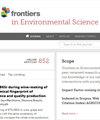An integrated mitigation approach to diffuse agricultural water pollution–a scoping review
IF 3.3
3区 环境科学与生态学
Q2 ENVIRONMENTAL SCIENCES
引用次数: 0
Abstract
Non-point source pollution and water eutrophication from agricultural runoff present global challenges that impact ground and surface waters. The search for a feasible and sustainable mitigation strategy to combat this issue remains ongoing. This scoping review aims to explore one potential solution by examining relevant literature on agricultural practices of the past and recent edge-of-field measures, designed to ameliorate the impacts of agricultural runoff on soil and water quality. The study focuses on integrating findings from diverse research fields into a novel myco-phytoremediation approach, which involves the synergistic relationship of plants, arbuscular mycorrhizal fungi, and plant beneficial bacteria within vegetative buffer strips. The implementation of these augmented buffer strips enhances nutrient retention in the soil, reduces runoff volume, promotes biodiversity, and increases plant biomass. This biomass can be converted into biochar, an effective sorbent that can be used to filter dissolved and particulate nutrients from surface waterways. The resulting nutrient-rich biochar can be repurposed as a form of bio-fertiliser, optimizing fertiliser consumption and subsequently reducing the depletion rate of phosphorus, a limited resource. This paper investigates a circular model of abatement of agricultural runoff via maximal nutrient retention and subsequent recycling of nitrogen and phosphorus back into the agricultural system. The key impact lies in its contribution to addressing the issue of non-point source pollution and eutrophication by encouraging multidisciplinary research aimed at solving these complex environmental issues.农业扩散性水污染综合缓解方法--范围审查
农业径流造成的非点源污染和水体富营养化是影响地下水和地表水的全球性挑战。为解决这一问题,人们一直在寻找可行且可持续的缓解策略。本范围综述旨在通过研究过去农业实践的相关文献和近期旨在改善农业径流对土壤和水质影响的田边措施,探索一种潜在的解决方案。研究重点是将不同研究领域的发现整合到一种新型的菌根植物修复方法中,该方法涉及植被缓冲带中植物、节肢菌根真菌和植物有益菌之间的协同关系。实施这些增强型缓冲带可提高土壤中的养分保持率、减少径流量、促进生物多样性并增加植物生物量。这些生物量可转化为生物炭,这是一种有效的吸附剂,可用于过滤地表水道中的溶解和颗粒营养物质。由此产生的富含养分的生物炭可以作为一种生物肥料重新使用,优化肥料消耗,从而降低磷这种有限资源的消耗率。本文研究了一种循环模式,通过最大限度地保留养分来减少农业径流,随后将氮和磷循环回农业系统。其主要影响在于通过鼓励旨在解决这些复杂环境问题的多学科研究,为解决非点源污染和富营养化问题做出了贡献。
本文章由计算机程序翻译,如有差异,请以英文原文为准。
求助全文
约1分钟内获得全文
求助全文
来源期刊

Frontiers in Environmental Science
Environmental Science-General Environmental Science
CiteScore
4.50
自引率
8.70%
发文量
2276
审稿时长
12 weeks
期刊介绍:
Our natural world is experiencing a state of rapid change unprecedented in the presence of humans. The changes affect virtually all physical, chemical and biological systems on Earth. The interaction of these systems leads to tipping points, feedbacks and amplification of effects. In virtually all cases, the causes of environmental change can be traced to human activity through either direct interventions as a consequence of pollution, or through global warming from greenhouse case emissions. Well-formulated and internationally-relevant policies to mitigate the change, or adapt to the consequences, that will ensure our ability to thrive in the coming decades are badly needed. Without proper understanding of the processes involved, and deep understanding of the likely impacts of bad decisions or inaction, the security of food, water and energy is a risk. Left unchecked shortages of these basic commodities will lead to migration, global geopolitical tension and conflict. This represents the major challenge of our time. We are the first generation to appreciate the problem and we will be judged in future by our ability to determine and take the action necessary. Appropriate knowledge of the condition of our natural world, appreciation of the changes occurring, and predictions of how the future will develop are requisite to the definition and implementation of solutions.
Frontiers in Environmental Science publishes research at the cutting edge of knowledge of our natural world and its various intersections with society. It bridges between the identification and measurement of change, comprehension of the processes responsible, and the measures needed to reduce their impact. Its aim is to assist the formulation of policies, by offering sound scientific evidence on environmental science, that will lead to a more inhabitable and sustainable world for the generations to come.
 求助内容:
求助内容: 应助结果提醒方式:
应助结果提醒方式:


